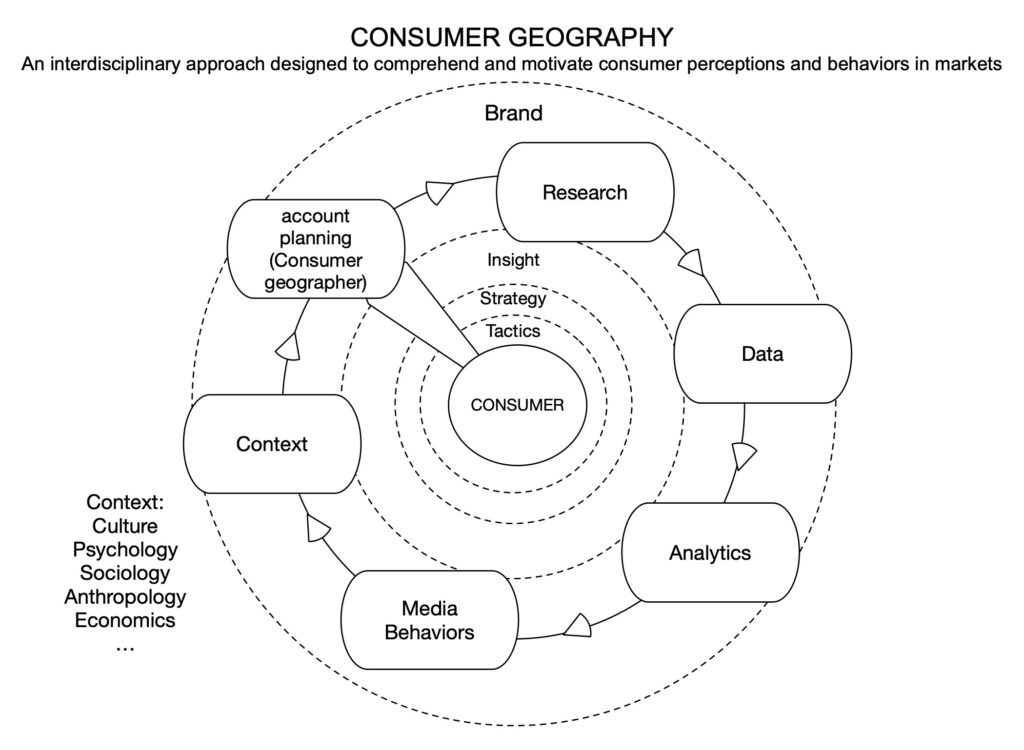
If we’ve learned one thing over the last few years, it is that our appreciation of nuance has diminished. More than ever, we’ve come to discount the distinctively human capacity to hold opposing ideas in our minds. Too often, we conveniently distill a person into one factor and ignore other interests, facets and tendencies.
For instance, identity politics is clarifying, on one level, but stymying on another. Marketing, like politics, is driven by those distillations or shortcuts when it comes to messaging. While it might seem grand to have one brilliant insight to drive a singular message, that insight must account for a variety of influences and even conflicting notions in the consumer’s mind.
With that broad, and hopefully not too subtle an observation, I suggest that message strategy in most agencies is often crafted on too narrow a sense of the consumer. This state of affairs is an invitation to a new notion of the buyer in our world of exchange. Borrowing from the field of “human geography,” which is driven by data, but also by interpretation of that data, let’s consider a special marketing case that might be labeled “consumer geography.”
The final objective of account planning must be to deliver an inspiring, insight-driven brief. Such a brief should guide not only creative development, but also media strategy and even product development. A more comprehensive brief might satisfy not only those opportunties, but also lead to more compelling creative that honestly addresses audiences. We may finally acknowledge that the target audience is not a homogenous collective. Rather, it might be many, sometimes dissimilar heterogenous subsets. A more expansive geographic survey might help meet that challenge.
Consumer Geography: A Definition
If we riff on a rather academic (Wikipedia) definition of human geography, we might draft a definition of consumer geography:
“… a nascent branch of the social sciences that deals with the study of people and their purchase behaviors;
- which attempts to comprehend consumers’ interactions with brands and the evolution of markets,
- by observing and acting to leverage or shape those behaviors and relationships in and across transactional scenarios,
- involves the exchange of currencies (monetary and otherwise) in the trade of goods and services and
- does so by the application of qualitative and quantitative research, analysis, interpretation, postulating, testing, etc. related to the consumer, culture and the context of consumption
- to arrive at actionable insights which can guide
- crafting, monitoring and optimizing messaging and various other appeals in the categories of brand, points of contact, product, pricing, promotion, placement.”
Yeah. It’s a mouthful, which takes us back to nuance. Many levers are in play. If you favor the perspective of Alan Hedges, you accept that consumers are willing to invest a degree of effort into making the first decision, but aim to automate the second and subsequent decisions. That can look a lot like loyalty. But, in today’s shopping environment, anything resembling loyalty is countered by the effervescence of The New, which brands seem more than happy to nurture. And consumers are fickle enough to encourage.
Even One Individual Is Rarely Of One Mind
Our dear consumer is a rather complex character, one capable of flipping preferences in an instant with the least warning or explanation. Almost any instance of consumer choice could illustrate the kind of left/right hemisphere duality explored by Iain McGilchrist in his book The Master And His Emissary.
Planners must figure out how to discern both the right/global/visionary and the left/local/administrative immediacies of an individual’s decision-making process. (Process suggests a rational or reasoning endeavor, which is likely a stretch!)
Extrapolating from a one to a many requires a genuine leap of faith only to be born out by testing and optimizing. Thus, other specialists may add knowledge, texture … nuance, to the consumer portrait being drawn in the consumer geographic planning process. A “department” devoted to consumer geography would reflect an interdisciplinary scheme that invites multiple perspectives with the aim being to comprehend nuance to shape message strategies.
In this construct, all manner of inputs are accorded and it is the responsibilty of the account planner, as it is traditionally, to capture valuable, actionable insights. But now, the pool of information about the consumer is expanded and enriched.
The account planner evolves into that of a consumer geographer, whose primary role is to assess and synthesize the wealth of information generated through these other augmented perspectives.

Integrated Marketing Must Be Guided By Interdisciplinary Planning
A robust consumer geography team could be assembled from a variety of specialties, with members studying the consumption scenario through the lenses of their expertise: research, media behaviors, anthropology, sociology, psychology, economics, even neurology. This list of specialities suggest that agency HR departments are drawing from a whole new range of candidates.
This model opens the door to agencies bringing on-board sociologists or anthropologists … specialists who can help see relationships and interactions that crude data might not ever reveal.
Of course, one can have too many inputs, so filtering is essential. Cost would play a role, as always. Many agencies to this day have a difficult time justifying fees for account planning. (After all, weren’t the account managers long positioned as strategists and market experts with a unique grip on the marketing challenge and target audience?) So a consumer geographic approach may require gambling on an upfront investment.
Few agencies could staff up the kind of specialists a fantasy-level consumer geography department would require. But even a small team of savvy folks could adopt these other perspectives … or look outside the agency’s four walls for plug and play expertise. A fully qualified economist, stoked with curiosity, diligence and a grasp of the unpredictablility of the consumer and the role of trade-offs might be sufficient to open new doors.
Why Bother?
One objective of such a group design would be to avoid routinization, group-think and even the confirmation bias that sometimes comes from the agency brand itself.
What evidence is available to support such an investment? In real world examples, I’ve worked on teams that moved from being purely hunch driven to a more informed approach leveraging attitudinal research designed to parse a specific marketing challenge, then to adding in knowledge of more granular media behaviors, then going further to bring into the fold transactional and behavioral data. Today, big data is routinely put to use, but perhaps overwhelming or short-circuiting the squishier, less measuable psycho-socialiological aspects of consumer decision-making.
Finally though, we need account planning to take advantage of the unique human ability to connect seemingly remote occurences or observations, to find linkages that stand the test of causality, not merely correlation, which at present appears to be the extent of big data crunching.
Perhaps a more interdisciplinary approach can support such an expansion – with dividends to the consumer and to the brand — in the account planning field.
Recent Comments